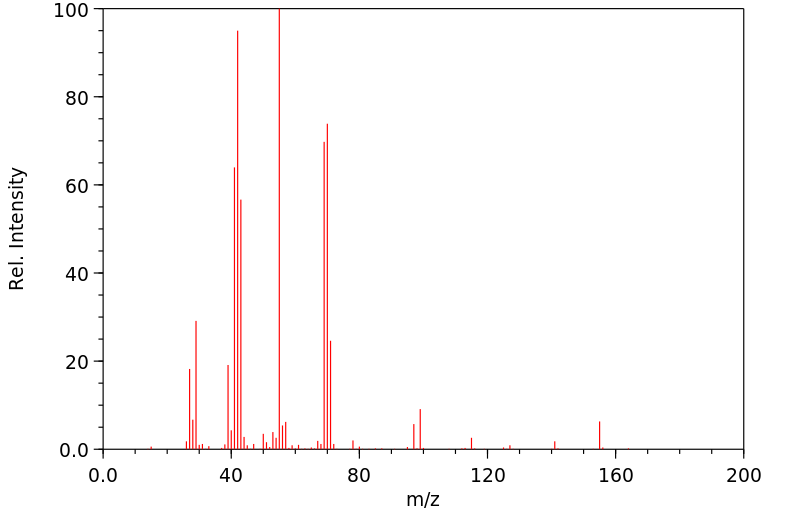trifluoroacetic acid n-pentyl ester | 327-70-8
中文名称
——
中文别名
——
英文名称
trifluoroacetic acid n-pentyl ester
英文别名
trifluoroacetate de pentyle;1-pentyl trifluoroacetate;n-Pentyl trifluoroacetate;1-amyl trifluoroacetate;pentyl trifluoroacetate;trifluoro-acetic acid pentyl ester;Acetic acid, trifluoro-, pentyl ester;pentyl 2,2,2-trifluoroacetate
CAS
327-70-8
化学式
C7H11F3O2
mdl
——
分子量
184.158
InChiKey
XJVUVRKPEBTMEC-UHFFFAOYSA-N
BEILSTEIN
——
EINECS
——
-
物化性质
-
计算性质
-
ADMET
-
安全信息
-
SDS
-
制备方法与用途
-
上下游信息
-
文献信息
-
表征谱图
-
同类化合物
-
相关功能分类
-
相关结构分类
物化性质
-
沸点:140-141 °C
-
密度:1.123±0.06 g/cm3(Predicted)
-
保留指数:752;752.1;761;755
计算性质
-
辛醇/水分配系数(LogP):3
-
重原子数:12
-
可旋转键数:5
-
环数:0.0
-
sp3杂化的碳原子比例:0.86
-
拓扑面积:26.3
-
氢给体数:0
-
氢受体数:5
安全信息
-
海关编码:2915900090
SDS
上下游信息
-
上游原料
中文名称 英文名称 CAS号 化学式 分子量 三氟乙酸酐 trifluoroacetic anhydride 407-25-0 C4F6O3 210.033
反应信息
-
作为反应物:描述:trifluoroacetic acid n-pentyl ester 在 水 、 [Cu(1-(8-(3,5-Cl2-C6H3)Naph)BIAN)(MeCN)]PF6 、 potassium hydroxide 作用下, 以 四氢呋喃 、 甲醇 、 二氯甲烷 为溶剂, 反应 10.0h, 生成 3-Ethyl-5,5,5-trifluoropentan-1-ol参考文献:名称:“三明治”二亚胺-铜催化卡宾插入未活化 C(sp3)−H 键的三氟乙基化和五氟丙基化摘要:“三明治”二亚胺-铜 (I) 络合物催化 CF 3 CHN 2和 CF 3 CF 2 CHN 2试剂与一大组烷基酯、卤化物和受保护胺中的 C(sp 3 )−H 键的反应,从而产生引入具有可预测的区域选择性的三氟乙基和五氟丙基。为了通用性和合成便利性,采用相同的CH官能化条件和化学计量。初步的机理研究指出了一种机制,涉及预平衡形成“三明治”-二亚胺铜-CF 3 CHN 2络合物,然后氮的决定速率损失,产生反应性铜卡宾,其与三氟甲基重氮甲烷的反应速度比与1的反应速度快约6.5倍。 -氟金刚烷解释了缓慢添加重氮化合物的必要性。DOI:10.1002/chem.202301672
-
作为产物:描述:参考文献:名称:2-(三氟乙酰氧基)吡啶作为胺和醇的温和三氟乙酰化试剂摘要:通过2-吡啶醇和三氟乙酸酐的反应制备了一种新的三氟乙酰化试剂2-(三氟乙酰氧基)吡啶(TFAP)。已发现 TFAP 在温和条件下对脂肪族和芳香族胺和醇(包括苯酚)的三氟乙酰化有效。对硝基苯酚与 TFAP 在乙醚中的反应得到苯酚和 2-吡啶酮之间的氢键配合物。该试剂还被证明可用于醛肟和酰胺的分子内脱水,以高产率得到腈。DOI:10.1246/bcsj.63.2252
文献信息
-
Site-Selective Aliphatic C–H Bromination Using <i>N</i>-Bromoamides and Visible Light作者:Valerie A. Schmidt、Ryan K. Quinn、Andrew T. Brusoe、Erik J. AlexanianDOI:10.1021/ja508469u日期:2014.10.15Transformations that selectively functionalize aliphatic C-H bonds hold significant promise to streamline complex molecule synthesis. Despite the potential for site-selective C-H functionalization, few intermolecular processes of preparative value exist. Herein, we report an approach to unactivated, aliphatic C-H bromination using readily available N-bromoamide reagents and visible light. These halogenations
-
[EN] HIGHLY SELECTIVE ELECTROCHEMICAL HYDROGENATION OF ALKYNES<br/>[FR] HYDROGÉNATION ÉLECTROCHIMIQUE HAUTEMENT SÉLECTIVE D'ALCYNES申请人:UNIV INDIANA TRUSTEES公开号:WO2020198464A1公开(公告)日:2020-10-01Disclosed are electrochemical methods to prepare an alkane or an alkene, such as a cis- alkene, from an alkyne, or an alkane from an alkene. The method utilizes an electrochemical cell having a cathode and an anode and a reactor.
-
A Simple Preparation of Alkyl Trifluoromethanesulfonates (Triflates) from Alkyl Trimethylsilyl Ethers作者:Corinne Aubert、Jean-Pierre BéguéDOI:10.1055/s-1985-31336日期:——Several alkyl trifluoromethanesulfonates (triflates) 2 are prepared by reacting alkyl trimethylsilyl ethers 1 with trifluoromethanesulfonic anhydride. The triflates 2 can be used for further reactions without isolation, as illustrated in the preparation of the ether 3 and cumene (4).
-
Catalytic Esterification of Alcohols, Carboxylic Acids and Transesterification Reactions with Cerium(IV) Triflate作者:Nasser Iranpoor、Marzieh ShekarrizDOI:10.1246/bcsj.72.455日期:1999.3reactions of alcohols with acetic, chloroacetic, trifluoroacetic, propionic, stearic, and benzoic acids were catalyzed with Ce(OTf)4 in a solvent or under solvent-free conditions with high yields. The formylation and acetylation of primary and secondary alcohols were also easily achieved in ethyl formate and ethyl acetate. A high retention of the configuration was observed in the acetylation and formylation
-
Synthesis and antibacterial activity study of a novel class of cationic anthraquinone analogs作者:Jianjun Zhang、Nathan Redman、Anthony Phillip Litke、Jia Zeng、Jixun Zhan、Ka Yee Chan、Cheng-Wei Tom ChangDOI:10.1016/j.bmc.2010.11.001日期:2011.19-diones has been further investigated. In the process of investigating the factors that control the selectivity and the biological activity associated with these two compounds, a novel class of antibacterial cationic anthraquinone analogs has been developed. Although these compounds are structurally similar, different antibacterial profiles are noted. One lead compound, 4e manifests high potency (MIC < 1 μg/mL)我们小组先前曾报道过,使用萘醌,叠氮化钠和烷基卤进行一锅环加成反应可导致形成1-烷基-1 H-和2-烷基-2 H-萘[2,3- d ]三唑- 4,9-二酮。在本文中,离去基团和添加剂对决定1-烷基-1 H-和2-烷基-2 H-萘[2,3- d]形成之间的选择性的影响]三唑-4,9-二酮已被进一步研究。在研究控制与这两种化合物有关的选择性和生物活性的因素的过程中,已开发出一类新型的阳离子阳离子蒽醌类似物。尽管这些化合物在结构上相似,但是注意到了不同的抗菌特性。一种先导化合物4e表现出高效力(MIC <1μg/ mL)和对革兰氏阳性(G +)病原体(包括耐甲氧西林金黄色葡萄球菌(MRSA))的选择性,同时对革兰氏阴性(G-)细菌仅发挥适度的活性。其他铅化合物(4f和4g)具有广泛的抗菌活性,包括MRSA和耐万古霉素粪肠球菌(VRE)可与其他市售阳离子消毒化学品媲美。抗菌特性的这种独特差异可能为新治疗剂的开发铺平道路。
表征谱图
-
氢谱1HNMR
-
质谱MS
-
碳谱13CNMR
-
红外IR
-
拉曼Raman
-
峰位数据
-
峰位匹配
-
表征信息
同类化合物
(甲基3-(二甲基氨基)-2-苯基-2H-azirene-2-羧酸乙酯)
(±)-盐酸氯吡格雷
(±)-丙酰肉碱氯化物
(d(CH2)51,Tyr(Me)2,Arg8)-血管加压素
(S)-(+)-α-氨基-4-羧基-2-甲基苯乙酸
(S)-阿拉考特盐酸盐
(S)-赖诺普利-d5钠
(S)-2-氨基-5-氧代己酸,氢溴酸盐
(S)-2-[[[(1R,2R)-2-[[[3,5-双(叔丁基)-2-羟基苯基]亚甲基]氨基]环己基]硫脲基]-N-苄基-N,3,3-三甲基丁酰胺
(S)-2-[3-[(1R,2R)-2-(二丙基氨基)环己基]硫脲基]-N-异丙基-3,3-二甲基丁酰胺
(S)-1-(4-氨基氧基乙酰胺基苄基)乙二胺四乙酸
(S)-1-[N-[3-苯基-1-[(苯基甲氧基)羰基]丙基]-L-丙氨酰基]-L-脯氨酸
(R)-乙基N-甲酰基-N-(1-苯乙基)甘氨酸
(R)-丙酰肉碱-d3氯化物
(R)-4-N-Cbz-哌嗪-2-甲酸甲酯
(R)-3-氨基-2-苄基丙酸盐酸盐
(R)-1-(3-溴-2-甲基-1-氧丙基)-L-脯氨酸
(N-[(苄氧基)羰基]丙氨酰-N〜5〜-(diaminomethylidene)鸟氨酸)
(6-氯-2-吲哚基甲基)乙酰氨基丙二酸二乙酯
(4R)-N-亚硝基噻唑烷-4-羧酸
(3R)-1-噻-4-氮杂螺[4.4]壬烷-3-羧酸
(3-硝基-1H-1,2,4-三唑-1-基)乙酸乙酯
(2S,4R)-Boc-4-环己基-吡咯烷-2-羧酸
(2S,3S,5S)-2-氨基-3-羟基-1,6-二苯己烷-5-N-氨基甲酰基-L-缬氨酸
(2S,3S)-3-((S)-1-((1-(4-氟苯基)-1H-1,2,3-三唑-4-基)-甲基氨基)-1-氧-3-(噻唑-4-基)丙-2-基氨基甲酰基)-环氧乙烷-2-羧酸
(2S)-2,6-二氨基-N-[4-(5-氟-1,3-苯并噻唑-2-基)-2-甲基苯基]己酰胺二盐酸盐
(2S)-2-氨基-N,3,3-三甲基-N-(苯甲基)丁酰胺
(2S)-2-氨基-3-甲基-N-2-吡啶基丁酰胺
(2S)-2-氨基-3,3-二甲基-N-(苯基甲基)丁酰胺,
(2S)-2-氨基-3,3-二甲基-N-2-吡啶基丁酰胺
(2S,4R)-1-((S)-2-氨基-3,3-二甲基丁酰基)-4-羟基-N-(4-(4-甲基噻唑-5-基)苄基)吡咯烷-2-甲酰胺盐酸盐
(2R,3'S)苯那普利叔丁基酯d5
(2R)-2-氨基-3,3-二甲基-N-(苯甲基)丁酰胺
(2-氯丙烯基)草酰氯
(1S,3S,5S)-2-Boc-2-氮杂双环[3.1.0]己烷-3-羧酸
(1R,5R,6R)-5-(1-乙基丙氧基)-7-氧杂双环[4.1.0]庚-3-烯-3-羧酸乙基酯
(1R,4R,5S,6R)-4-氨基-2-氧杂双环[3.1.0]己烷-4,6-二羧酸
齐特巴坦
齐德巴坦钠盐
齐墩果-12-烯-28-酸,2,3-二羟基-,苯基甲基酯,(2a,3a)-
齐墩果-12-烯-28-酸,2,3-二羟基-,羧基甲基酯,(2a,3b)-(9CI)
黄酮-8-乙酸二甲氨基乙基酯
黄荧菌素
黄体生成激素释放激素(1-6)
黄体生成激素释放激素 (1-5) 酰肼
黄体瑞林
麦醇溶蛋白
麦角硫因
麦芽聚糖六乙酸酯
麦根酸







